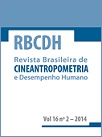Influence of number of days and valid hours using accelerometry on the estimates of physical activity level in preschool children from Recife, Pernambuco, Brazil
DOI:
https://doi.org/10.1590/1980-0037.2014v16n2p171Abstract
A few studies have proposed the number of hours/day and the number of days of monitoring that should be completed to obtain good quality accelerometry data for preschool children. The aim of this study was to analyze how the estimates of physical activity levels and sample profiles (demographic and anthropometric data) vary according the use of different criteria to define valid monitoring periods. Children (n=180) aged three to five years were randomly selected among participants from a longitudinal study performed in Recife, Brazil. Children wore a GT1M Actigraph accelerometer on the right waist during a period of seven days, including the weekend days, using 15 s epochs. A total of 176 children were included in the study (52.8% boys; mean age of 4.3 years [s=0.8]). Using the criterion of 10+ hours/day of wearing time to define a valid monitoring day, 67.0% (n=118) and 36.9% (n=65) of the children showed 3+ and 5+ valid days, respectively. When the criterion of 5+ hours/day was used, the time spent in moderate activity was approximately 10 minutes shorter than when the criterion of 10+ hours/day was used. The criterion of 10+ hours/day for defining a valid monitoring day leads to a sample size reduction and the criterion of 5+ hours/day underestimates the moderate activity level.



